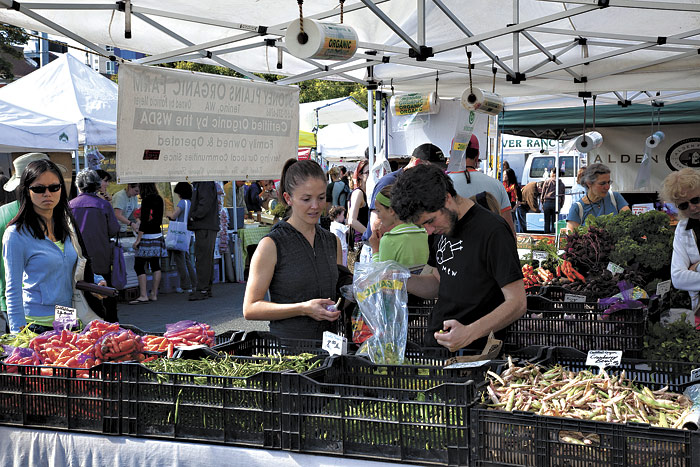Chris Curtis, director of Seattle’s Neighborhood Farmers Market Alliance, calls 2008 a golden year for farmers markets in America, “because of the media focus on local foods and Michael Pollan’s book [In Defense of Food]—an amazing confluence of good information about the benefits of shopping at farmers markets.” Thanks to the great publicity last year, shopper counts and farm sales at her six markets (which include U District and West Seattle) jumped.
This year, though, the recession has hit. All around Puget Sound, farmers, farmers-market vendors, and market organizers like Curtis are reporting that sales have dipped. The funny thing is, this is one of the few areas where this drop is occurring. Though no national farmers-market sales data exists, Stacy Miller, head of the national Farmers Market Coalition, says, “in other regions, I hear the exact opposite is the case, particularly in areas where farmers markets and local food systems are still growing in number, size, and popularity.” Jackie Aitchison of the Washington State Farmers Market Association adds that throughout the state, most markets are seeing about a 10 percent increase in sales over last year.
Tell that to Wade Bennett, who mans the Rockridge Orchard stand at the Columbia City market. Bennett planted all 1,200 apple and pear trees on his Enumclaw land himself, and is a longtime farmers-market participant who sells at eight markets in Seattle and Bellevue. “We’re down 17–20 percent total gross,” he says. Giving a peculiar twinge to the sales decline is that this year was so fantastic for productivity. With last December’s fierce weather and the heat wave this summer, his trees have exploded with beautiful fruit. And while less money is coming in, Bennett’s labor, insurance costs, and taxes haven’t changed. “Farmers make an average of 15–20 percent net profit, so if the prices drop, it’s really difficult.” (If 20 percent net profit seems fantastic, Bennett says it means he’s essentially earned $1.50–$2 an hour for his work on the farm and farm stand.)
Anita Ross of Anita’s Crepes, whose cooks rock turntable-like crepe irons at 11 markets around the Puget Sound, has the same complaint. “Gross sales are down more than 30 percent,” she says. “It’s odd, because they’ve gone up every year before that.”
As a host of news stories have reported, grocery sales around the nation are down. It’s not that people are shopping less, it’s that they’re buying cheaper, and thinking more about what items are essential. And the same thing appears to be happening at farmers markets, where the organic, local food often comes at a premium. Even within the farmers market, as Bennett says, “the drop seems to be hitting most at the high end—heirloom tomatoes, breads, wines—while things like lettuce, potatoes, and fruit are doing fine.” A swing around the Columbia City Market last week seemed to bear witness to that: Farmers selling produce at the largest Seattle markets reported they were holding tight, while flower sellers and prepared-food vendors have noticed greater dips.
While Curtis reports that she’s only seeing a 2 to 3 percent total drop in sales (and that includes the Broadway Market, which grew this year and has seen sales jump 15 percent), the vendors are showing higher negative numbers. Competition is partially to blame. As many of the markets grow, individual farmers are finding that they’re competing within the market—shoppers can choose from four cherry sellers instead of two, or one more baker selling equally good danishes. Tweaking the mix of farmers and products is one of the central problems for any farmers market, Curtis says, and an issue the alliance monitors year after year. Jodi Bardinelli, director of the Kirkland Wednesday Farmers Market, says her market has survived a move this year to the waterfront without seeing total sales decrease. Nevertheless, the market has grown, and she’s been disappointed to lose a couple of good vendors who’ve complained they couldn’t make enough money there. “You come with a $20 bill, and you can only spend it once,” she says. “You’ve got to make it go farther.”
What hasn’t changed—in fact, what seems to be increasing—is the popularity of neighborhood farmers markets. There are three new markets in the Puget Sound area this year, plus two Pike Place Market satellite “mini-markets.” While some of the more established markets are seeing slight drops in traffic, others are seeing the crowds roll in. Jon Hegeman, founder and organizer of the Ballard Farmers Market, as well as markets in Wallingford, Madrona, and the new one in Fremont, says his four markets are holding even precisely because they continue to gain in popularity. [This story has been corrected since it was first posted. It originally listed the Queen Anne Farmers Market among those run by Hegeman. That market is now independently operated.] The Ballard Sunday market has seen traffic rise from 7,000 a day to 10,000 in two years. “We have noticed a slight dip in the amount of money [individual] people are spending,” he says, “but with the rise in attendance, the vendors haven’t noticed a decrease in revenues, which is really good.”
As numerous organizers and vendors mention, farmers markets are a cheap, rewarding family event. You walk around for an hour, you fill your canvas tote with a few things and buy a pastry for your kids, and you people-watch. Sure, you’re not picking up a bouquet of flowers this time, and you’re definitely cutting back on the organic peaches, but you and your family are still there, week after week. Hegeman thinks that his markets’ inclusion of crafters, community tables, and musicians is what’s keeping the customers rolling in. “Our idea here is that the markets are builders of community and the hub of community,” he says.
In fact, though people like Ross and Bennett might not be able to revel in the news, this drop in sales may just be a measure of success.
For one thing, the organic, local farmers you see every week—even the ones reluctantly reloading their trucks at the end of the afternoon—are still ahead of the game. This month, the USDA projected that net farm income in America in 2009 will be down 38 percent. Rising input costs—fuel, feed, and fertilizer prices—have combined with declining farm sales to create a massive slump. Smaller farms doing direct sales seem to be more insulated.
The reason Seattle may be one of the few metropolitan areas in the country to see farmers-market sales go down is because we’ve been on the forefront so long. In the two decades since the Fremont and U District markets began, Seattle has developed one of the most comprehensive networks of neighborhood farmers markets. So many places in the country—including New York and San Francisco—are catching up, expanding from a few major markets to a web of smaller, more dispersed ones. By contrast, Seattleites now expect to have a farmers market in their own neighborhood; Hegeman says he’s fielding strong proposals from three more neighborhoods who want their own.
And farmers markets aren’t just competing against one another. Customers shopping for local, organic produce don’t have to wait for one day of the week to do their shopping—we’ve got Metropolitan Market, the Ballard Market, and co-ops like the Madison Market and PCC. [This story has been corrected here. It originally did not identify PCC as a co-op.] Not only that, but Safeway and QFC have launched campaigns essentially rebranding their suppliers as “local farmers,” and people who care about shopping local but aren’t as picky about the source of their fruit can shop there—and at 11:30 at night when they get off work, Curtis adds.
So if there’s a success story re the growth of local food systems, we’re it. Which is why ours is big enough—and saturated enough—to feel the recession. Unfortunately, there’s no quick remedy. As Bennett mentions, farmers who don’t receive USDA subsidies can’t afford to reduce prices. Will there be there a culling in the near future, when less-productive markets will shrink or disappear while the major ones grow? It’s hard to say. In the best-case scenario, the drop we’re seeing now is a prelude to a new surge. Just as we’re supposed to invest in our 401(k) when the market’s down, if markets can attract bigger numbers of budget-conscious customers now and get them in the habit of shopping regularly, as flusher times return they’ll drop more and more money.
“Truth be told, I’m tired of hearing about the recession,” Bennett concludes. He hands over an Asian pear. “Taste that,” he says. It’s so rich and caramelly, it tastes as if it were injected with Cognac. “You can’t get that at the grocery store. That’s the reason you come here.”






